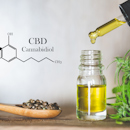
Clearing the Confusion on CBD
Cannabidiol (CBD) has gained a strong presence in the nutritional industry, and most likely in your email box, various news feeds, your patient's interest, and possibly their treatment regimen, leaving practitioners looking for clarity.
The 2018 United States Farm bill, which under the direction of the USDA, legalized industrial hemp that has a tetrahydrocannabinol (THC, the psychoactive component of marijuana) concentration of no more than 0.3%, and was removed from schedule I of the Controlled Substances Act (Hudek, 2018; Brightfield Group, 2019).
The USDA has handed medicinal and recreational usage of hemp over to the FDA, where there is a regulatory landscape of significant confusion for the public, suppliers, practitioners, retailers and state regulators as the FDA has yet to decide on an official classification and enforcement policy (Fletcher, 2019).
FDA enforcement to date has been limited to targeting manufacturers of CBD-containing products promoting the most egregious of health claims, the agency has no official enforcement discretion policy at the present time.
What’s the Difference between Hemp, Marijuana, CBD, and THC?
Both Hemp and Marijuana are part of the cannabis family. CBD and THC are the two most abundant cannabinoids of over 100 found in cannabis. Where THC is the psychoactive component, and CBD is the non-psychoactive (Pertwee, 2002).
CBD, THC, as well as other phytocannabinoids and cannabis constituents, work within, and even beyond the endocannabinoid system. Where CBD from hemp is required to have 0.3% THC or less, this will not elicit a psychoactive effect, although could still test positive on a drug test (Pacher, Batkai & Kunos, 2006).
The endocannabinoid system (ECS) is a master regulator of all biological systems in maintaining homeostasis. The ECS is comprised of cannabinoid receptors (CB1 and CB2), endogenous cannabinoids (anandamide and 2-AG), and enzymes (MAGL and FAAH) which are responsible for the synthesis and degradation of the endocannabinoids (Zou, & Kumar, 2018).
CB1 receptors are found throughout the body, while most abundantly throughout the CNS; involved in the movement, coordination, emotion, perception of pain, memory, cognition, and endocrine function (Pertwee, 2002). CB2 receptors are also found throughout the body, although most abundantly in the periphery influencing immunity, inflammation, gut health, and pain.
CBD has a little direct effect on CB1 and CB2 receptors. CBD indirectly influences CB1 and CB2 receptors by increasing levels of the body’s own endocannabinoids, anandamide, and 2-AG, by inhibiting their degradation via modulating the FAAH and MAGL enzymes. As a result, more anandamide and 2-AG are available to activate cannabinoid receptors (Zou, & Kumar, 2018).
The endocannabinoid system has proven to be a profound regulatory system for one’s health, with far-reaching effects. CBD has shown to be a major player in supporting the endocannabinoid system and thus can play a key role in supporting people’s health for numerous reasons (Pacher, Batkai & Kunos, 2006).
Continued research and discovery about the endocannabinoid system as well as phytocannabinoids and other constituents will most likely continue to make a strong impact on the health care industry. Until the FDA sets regulatory grounds, the legal gray area leaves many questions on where the industry can go. And while even in regulatory limbo, depending on the source, the CBD market is expected to grow to approximately 20 to 22 billion dollars by 2022-2024.
As far as products are concerned, quality, transparency, and efficacy will lead the industry.
A health care practitioner knowledgeable in the field of cannabis will become an increasingly sought resource, with the ability to provide the needed direction and information to patience in attaining their health goals. Find more information on Alternative Medicine in RN.com's continuing education courses.
References
ABrightfield Group. (2019) Hemp-derived CBD market to reach $22 billion by 2022. Brightfield Group.
Fletcher, L. (2019). The risk of contaminants and false labeling in the exploding CBD industry. WJLA.
Hudek, J. (2018). The farm bill, hemp legalization and the status of CBD: An explainer. Brookings.
Pacher, P., Batkai, S., Kunos, G. (2006). The endocannabinoid system as an emerging target of pharmacotherapy. Pharmacological Reviews. 58 (3) 389-462.
Pertwee, R., (2002) Pharmacology of cannabinoid CB1 and CB2 receptors. Science Direct.
Zou, S., Kumar, U.. (2018) Cannabinoid receptors and the endocannabinoid system: Signaling and function in the central nervous system. International Journal of Molecular Sciences. 19(3), 833.




